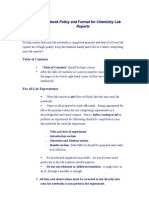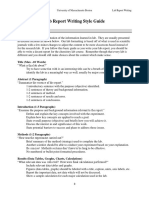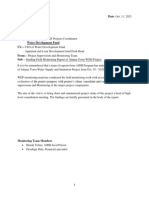Report_Writing_Introduction_Fall_2023
Uploaded by
juanarielvaldezReport_Writing_Introduction_Fall_2023
Uploaded by
juanarielvaldezHow to write your Full Laboratory Report
Goals: Write a scientific mini-paper with all sections, including:
- Abstract
- Introduction
- Methods
- Results
- Discussion
- Conclusion
- References
How to start? – Follow this order and the associated explanations:
1) Write the Methods section. What did you do in the lab, include all chemicals, lab
instrumentation (a burette is an instrument!) and describe the procedure. ABSOLUTELY
NO EXPLANANTIONS why you did specific steps or use specific instrumentation. Be as
explicit as possible and do not justify or explain any procedure. Include which data
analysis you performed and which error analysis (if applicable).
a. It is often good to start this section with a paragraph mentioning all chemicals
and consumables used.
b. Then describe the experimental procedures in as much detail so that another
chemist can reproduce your experiment.
c. If instruments are used, name the model of the instrument and supplier.
d. Mention details on the standard solutions and how they were prepared.
Describe the preparation of calibration solutions (if prepared).
2) Write the Results and Discussion section:
a. Gather all your data first!
b. Perform all necessary calculations, plot your data (a preliminary plot is ok at this
stage)
c. Decide on which form your data should be presented, in form of a table or a
particular graph. Decide if a drawing might be included (e.g. for the
instrumentation, a diagram of how the instrument works can should be included
prior to stating your results). If you add instrument schematics in the
introduction, do not repeat it here.
d. Once you decided on the figures, write concise but short figure legends for each.
For tables, come up with a short, concise title. Make sure that the data
representation is adequate. Check axis labelling and plot your data in a suitable
range of x- and y-axis values. Also check that the axis labels including numbers
are legible. Provide a suitable legend for each figure (e.g. in color and/or symbol
shape).
e. Next, write a short paragraph about the main outcome for each data table and
graph.
f. Then amend these paragraphs with the discussion.
i. What are the errors associated with your measured data?
ii. Compare to literature values and discuss if your result is similar or
different to reported literature values. (At this point you can make
placeholders for references, if you have them available. Later rework the
entire document to number references consecutively.)
iii. If you results deviate significantly from the literature, explain why.
g. Now find suitable wording to connect your paragraphs to make it a “story”.
Include a short first paragraph before the results and discussion to explain the
purpose of the experiment.
3) Write the Conclusion section:
a. After having finalized the results and discussion section, summarize the
experiment in a short 1-2 paragraph conclusion.
4) Write the Introduction section:
a. Because you have a clear picture of the experiment and its outcomes at this
point, write an introduction that contains a background about the experiment
and procedure/method used and why it is important. Explain the chemical
reactions occurring in the experiment (if appropriate). Include references in this
section for the cited methods and other original literature you use in this section.
5) Insert Reference Numbers in consecutive order in the text and list the citation at the
end of the document in consecutive order. Follow ACS style for the references. You can
use a reference editor for this purpose (Refworks, Endnote, Mendeley, etc. )
6) The very last section is the Abstract. Once all is written and in order, write the abstract.
It will give a short motivation of the work and a very short summary of the outcome
(results). The abstract is one paragraph long.
7) Organize your work: If you find that the flow in the introduction or results and
discussion section is not good, change the order and/or improve the transition between
paragraphs. You may include headings for specific sections to organize your work. Put
yourself into the position of an editor and criticize your writing. Can you understand
what you wrote, and does it make sense?
8) Check your work for Grammar. Use your text editor for grammar check or an online
source. The report needs to be written in third person.
You might also like
- Civil Engineering Lab Report Format Final PDF100% (1)Civil Engineering Lab Report Format Final PDF4 pages
- Lab Reports: Formal Lab Reports For This Course Will Consist of The Following: Format: 12-pt Font, W/ 1.5 Spacing (At Least) o Title PageNo ratings yetLab Reports: Formal Lab Reports For This Course Will Consist of The Following: Format: 12-pt Font, W/ 1.5 Spacing (At Least) o Title Page3 pages
- How To Write A Lab Report To Impress Your TA PDFNo ratings yetHow To Write A Lab Report To Impress Your TA PDF5 pages
- CHY 47.1 1stsem Formal Report SY 2022 2023No ratings yetCHY 47.1 1stsem Formal Report SY 2022 20233 pages
- Criteria For Writing A Formal Lab Report (Spring 2023) - 1No ratings yetCriteria For Writing A Formal Lab Report (Spring 2023) - 15 pages
- Lab Notebook Policy and Format For Chemistry Lab ReportsNo ratings yetLab Notebook Policy and Format For Chemistry Lab Reports5 pages
- Writing a Formal Lab Report General for SciencesNo ratings yetWriting a Formal Lab Report General for Sciences7 pages
- Guidelines For Writing A Lab Report: Cover PageNo ratings yetGuidelines For Writing A Lab Report: Cover Page3 pages
- Civil Engineering Lab Report Format FinalNo ratings yetCivil Engineering Lab Report Format Final4 pages
- Laboratory Report Format: What and Why How What You Found What It MeansNo ratings yetLaboratory Report Format: What and Why How What You Found What It Means4 pages
- General Outline of A Laboratory Report (BNA30803)No ratings yetGeneral Outline of A Laboratory Report (BNA30803)2 pages
- THIS IS A FORMAT OF AN Investigatory ProjectNo ratings yetTHIS IS A FORMAT OF AN Investigatory Project2 pages
- SCT111 - Notes On Lecture 1, LAB Report WritingNo ratings yetSCT111 - Notes On Lecture 1, LAB Report Writing2 pages
- 137378 - КПП CASE 580LE - 580SLE 4WD - ŞANZIMAN -No ratings yet137378 - КПП CASE 580LE - 580SLE 4WD - ŞANZIMAN -17 pages
- Altitude Hold and Speed Control - Installation, Setup and OperationNo ratings yetAltitude Hold and Speed Control - Installation, Setup and Operation8 pages
- EAT237 Microprocessors and PLC's - PLC PartNo ratings yetEAT237 Microprocessors and PLC's - PLC Part5 pages
- VAL 070 Cleaning Validation Analytical Methods SampleNo ratings yetVAL 070 Cleaning Validation Analytical Methods Sample2 pages
- Kubernetes Programming with Go: Programming Kubernetes Clients and Operators Using Go and the Kubernetes API 1st Edition Philippe Martin All Chapters Instant Download100% (3)Kubernetes Programming with Go: Programming Kubernetes Clients and Operators Using Go and the Kubernetes API 1st Edition Philippe Martin All Chapters Instant Download40 pages
- Instructions For CU Triaxial Using Triflex DS7No ratings yetInstructions For CU Triaxial Using Triflex DS713 pages
- Electrical Wiring Regulations, 2012 (L.i. 2008)0% (1)Electrical Wiring Regulations, 2012 (L.i. 2008)144 pages
- GAI Workshop L200 Budiling With GenAI On AWS ASEANNo ratings yetGAI Workshop L200 Budiling With GenAI On AWS ASEAN87 pages
- Field M.report (Adama Town WSSP, Oct.2023)No ratings yetField M.report (Adama Town WSSP, Oct.2023)13 pages
- Unit 10: Exercise 1: Listen and Write The Technology Words You HearNo ratings yetUnit 10: Exercise 1: Listen and Write The Technology Words You Hear12 pages
- 5 - Analog Scaling - (FreeCourseWeb - Com)No ratings yet5 - Analog Scaling - (FreeCourseWeb - Com)8 pages
- Make 700$ in A Week..tested and Confirmed Method Https://lootbits - Io/?invite 1722077No ratings yetMake 700$ in A Week..tested and Confirmed Method Https://lootbits - Io/?invite 17220774 pages

























































































